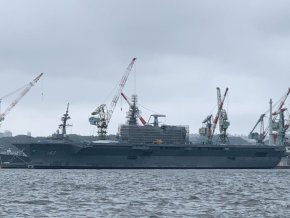Some regional updates & JMSDF developments
1. Navies working together gives us the best chance for a peaceful outcome, to regional tensions — there is a strong incentive for the small navies to work with larger navies, to hone their skills.
2. Thanks to the Japanese PAO, we have these lovely images to share of four navies training and working together (namely, Australia, Brunei, Japan and Singapore), in this multi-national group sail, even before the start of RIMPAC 2020.
3. Japan's Acquisition Technology and Logistics Agency (ATLA)
announced on 9 Aug 2017 the launch of a new surface vessel programme called 30DX for the JMSDF with Mitsubishi Heavy Industries (MHI) selected as prime contractor. The first ship of the class is nearing completion. Prime Minister Abe has repeatedly earmarked increased funding for the nation's defence budget, expanding the capabilities of the Japan Self-Defense Forces (JSDF) with plans to repeal the post-Second World War constitutional limitations and reinstate a power projection focused force structure and doctrine to be supported by Japan's industrial capability to modernise and equip itself in the face of growing regional instability and tensions.
4. Following approval in December 2018 for the conversion of the Izumo Class into aircraft carriers, imagery has emerged of the JNS
Izumo as it undergoes the major structural modification and conversation to enable the vessels to host the F-35 and V-22 Osprey's planned to support the burgeoning anti-submarine, amphibious and expeditionary capabilities Japan currently has in development. The US$28 million modifications underway at Yokohama will clear and reinforce Izumo’s deck in order to transform the vessel from a helicopter carrier into a light aircraft carrier capable of supporting Japan’s 42 F-35B STOVL fighter jets.
5. It is envisaged that the modernised and converted Izumo Class will provide tactical and strategic mobility for the JSDF and enable them to support the rapid response deployment of the Japan Ground Self-Defense Force's (JGSDF) 'Amphibious Rapid Deployment' brigade.
6. This JSDF amphibious unit is similar to US Marine Expeditionary Units designed to defend Japanese interests in the South China Sea, namely the Senkaku Islands, which have served as a flash point between China and Japan.
7. Beyond Increased naval activities, the JSDF has its own A2AD strategy for the defence of its islands.
8. It is ironic that 75 years since WWII ended in the Pacific with Japan's surrender, the country has returned back to operating carriers. The outcomes of the war in the Pacific can still be seen and felt today. Due to Japan's history of offensive operations during WWII, for decades, the JMSDF was prevented from operating aircraft carriers (as these were considered to be offensive weapons systems – capable of supporting power projection doctrines and 'hard power' policies).
9. In 2020, the region (except for China), welcomes Japan’s return to carrier aviation due to growing uncertainty of the regional security environment. JMSDF’s exercises with ASEAN navies is seen to promote a balance of power that favours ASEAN interests by strengthening their partnerships and military presence vs the PLA(N)’s attempts to unilaterally challenge the status quo through militarisation, provocation, gray-zone coercion, and salami slicing.



